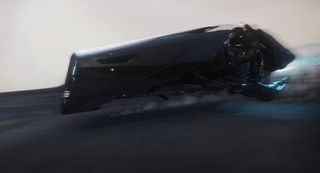First man on the moon: hands-on with Star Citizen Alpha 3.0
I landed on a moon in a build of the upcoming 3.0 update, and now I feel like a real (virtual) astronaut.
Star Citizen fans have been eagerly awaiting the arrival of Alpha 3.0, currently scheduled for a release in late August. To whet your appetite even more than it is presumably already whetted, take a look at a cinematic sizzle reel of Star Citizen footage above, which shows many of the new features due to arrive in 3.0, like moon landings, planetary rovers and outposts, and the Nox hover speeder.
I'm also pretty stoked to say I got to play a build of 3.0 during a visit to Cloud Imperium Games' Los Angeles studio a couple of weeks ago, and got to check out some of its new features. Yep, I landed a ship on the moon of Daymar—and according to Chris Roberts, I'm the first person outside of CIG to have done so. After touchdown, I got out of my ship, walked around on the surface of the moon, completed a mission, and even flew a Nox speeder bike around for a bit.
All of this was pretty darn cool to do. Since my landings in Star Citizen to date (most of them crashes) have taken place only on space stations, actually landing on a moon felt pretty monumental, like I'm a genuine (virtual) astronaut now, even though I forgot to make a stirring statement and wasn't able to plant a flag (frankly, I was just relieved to have not crashed my ship, especially with a bunch of expert pilots from CIG watching me). As promised, it was a seamless transition: taking off from the space station, flying into space, making a quantum jump to the Daymar, entering the atmosphere, and landing.

Another welcome addition to Star Citizen may sound minor, but I think it's wonderful: the ability to change your movement speed while traveling on foot by scrolling the mousewheel. It was one of the first changes I got to see in 3.0, and I played with it for a while—probably too long, considering I was supposed to be exploring moons, not pacing around the interior of a space station. It's just neat, gradually switching from a slow walk to a normal strolling pace to a quickened walk, then to a jog, and finally to a run, all by simply rolling the mousewheel forward. Scroll the other way, and you'll gradually go from a run to a walk.
Being able to pick intermediate speeds between a walk and a run makes movement feel more realistic (akin to using a controller's thumbstick for the throttle in a racing game) and the animation smoothly reacted as I changed my pace from walking to running and back. All those games where you're either slightly slower or slightly faster than the NPC you're following around, and you have to keep switching between a walk and a sprint? Can't see it being a problem here.

I did lots, lots more with my time in Star Citizen 3.0, and you'll be able to read about the new mission I completed, my visit to a former mining colony on the surface of an asteroid, the multiplayer battle I got into on Daymar, what it's like to fly the new Nox speeder, and several other new features I got to check out (as well as what CIG has planned for Star Citizen beyond the 3.0 update) in the next issue of PC Gamer Magazine. Here's how to subscribe, and you can also join the PC Gamer Club, which gives you a digital subscription to the magazine, an ad-free browsing experience on this site, and a bunch of other goodies.
At best, I've been a casual fan of Star Citizen thus far—it's something I'll jump into for an evening every couple of months to fly around a bit, crash a bit, or spend a few hours trying to sneak aboard other people's ships (they're adding locks to ship doors, so that particular pastime may be ending soon, or at least it'll become a bit more complicated). But having moons to land on and explore, finally, is exciting. Space is great, and space stations are cool, but there's something about seeing a moon in the night sky and being able to fly to it and land on it that makes me feel like a real (virtual) spaceman. I enjoyed my brief time with the 3.0 build, and now I find myself anxious to return and plant my boots on terra firma once again.
PC Gamer Newsletter
Sign up to get the best content of the week, and great gaming deals, as picked by the editors.

Chris started playing PC games in the 1980s, started writing about them in the early 2000s, and (finally) started getting paid to write about them in the late 2000s. Following a few years as a regular freelancer, PC Gamer hired him in 2014, probably so he'd stop emailing them asking for more work. Chris has a love-hate relationship with survival games and an unhealthy fascination with the inner lives of NPCs. He's also a fan of offbeat simulation games, mods, and ignoring storylines in RPGs so he can make up his own.
Most Popular





